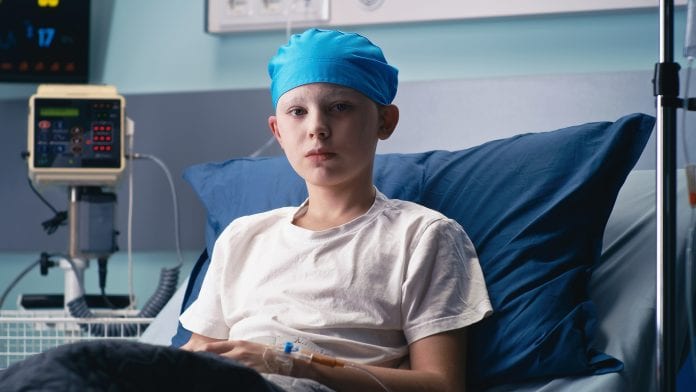
A new genetic discovery could lead to improvements in treatment and increased survival rates for the aggressive cancer rhabdomyosarcoma.
Rhabdomyosarcoma is a rare type of cancer that develops from cells in the supporting or connective tissues of the body and mostly affects children and teenagers. In a study designed to further understanding of the disease, researchers from The Institute of Cancer Research, London, discovered a series of key genetic changes underlying its development.
The study found that specific genetic changes in tumours are linked to aggressiveness, early age of onset, and location in the body. All these factors affect children’s survival chances, and understanding how they are driven by a cancer’s genetics could lead to new ways of tailoring treatment for each patient. Currently, less than 30% of children with rhabdomyosarcoma who have relapsed or whose cancer has spread will survive.
The research, which was funded by Cancer Research UK and several charities who fundraise specifically for research into rhabdomyosarcoma— the Chris Lucas Trust, Talan’s Trust, and Alice’s Arc— was published in the Journal of Clinical Oncology.
Researchers hope that the findings could help pick out children with particularly aggressive cancers in need of intense treatment and close monitoring. It could also identify other children who could benefit from less aggressive therapy and could be spared some of the most severe side effects of treatment.
Types of rhabdomyosarcoma
There are two main sub-types of rhabdomyosarcoma – fusion gene-positive and fusion gene-negative, depending on the presence of a ‘fusion gene’. A fusion gene is a hybrid gene formed from two previously separate genes – in this case, a PAX gene and a gene called FOXO1.
The international group of researchers analysed the DNA from 641 patients with rhabdomyosarcoma. When looking at children with fusion-negative rhabdomyosarcoma, researchers found that children whose tumours had faults in the genes MYOD1 and TP53 had significantly poorer response to treatment and worse survival outcomes. TP53 was altered in 69 out of 515 children and was linked to worse survival outcomes.
Around half of the children whose cancers had TP53 mutations succumbed to the disease, compared with one in four children with cancers that were not TP53 mutant – indicating that those without the mutation had a better chance of survival.
The researchers found mutations in MYOD1 in 17 out of 515 children and linked these to both worse outcomes and rapid progression of the disease. The findings suggest that children with these mutations could benefit from more aggressive treatment.
A small number of children with fusion-positive rhabdomyosarcoma – five out of 126 – also had changes in TP53. None of these children survived their cancer and, as a consequence, researchers have identified TP53 as a ‘high risk’ indicator in this sub-group too.
Researchers believe having too many copies of the genes CDK4 or MYCN may also be linked to a poorer outcome in fusion-positive rhabdomyosarcoma, with 16 and 13 cases, respectively, showing these genetic changes. However, as the number of cases in the study was small this needs to be explored further in future research.
Rhabdomyosarcoma in babies
The new study challenges previous findings that the presence of a fault in the RAS gene is linked to poor outcomes. Researchers did, however, find that some RAS mutations seemed to be correlated with particular ages of onset – with HRAS mutations arising in babies, KRAS mutations in toddlers, and NRAS mutations in adolescence.
Babies have previously been shown to have lower survival chances than older children, which may be because clinicians avoid using more aggressive treatments like radiation in the youngest patients. Taking into account findings from this study, researchers believe that using targeted drugs such as tipifarnib, which blocks HRAS, may be particularly beneficial for these young, vulnerable, and high-risk patients.
Understanding genetic changes
Study leader Janet Shipley, Professor of Molecular Pathology at The Institute of Cancer Research, London, said: “Our findings shed light on the genetic changes that underlie rhabdomyosarcoma, a rare and aggressive childhood cancer. By looking at the genetic features of different tumours, we can divide children into different risk groups to help guide their treatment.
“Decades of clinical trials have led to the current complicated system for assigning risk to children with rhabdomyosarcoma – but we know that the current system is not accurate enough to properly assign treatment for individual children. Our findings should refine the current system and treatments clinicians provide to more effectively match each child’s genetic profile and risk. Ultimately, further research may highlight new drugs to tailor treatment for patients with high-risk rhabdomyosarcomas that have specific genetic defects.”
Professor Paul Workman, Chief Executive of The Institute of Cancer Research, London, said: “This international collaborative effort has linked specific genetic changes in cancers to the ways that children respond to treatment. It should help clinicians to treat children according to the particular features of their cancer and the risk they face of their cancer progressing. The findings have the potential to have a real impact not only on survival but also on quality of life, by picking out those children who need the most aggressive treatment, but also sparing others with lower-risk disease from the side effects of intensive interventions.”
Alice’s Arc was inspired by Sara and David’s daughter Alice who, at the age of three, was diagnosed with rhabdomyosarcoma. Alice’s Arc was established just after her diagnosis. Alice died at aged just seven.
Sara Wakeling, Co-founder of Alice’s Arc, said: “We believe the future of treating rhabdomyosarcoma effectively and kindly is reliant on understanding the features of each individual’s tumour and tailoring treatment accordingly. We are delighted to have played a role in helping to build understanding of these genetic features of rhabdomyosarcoma tumours and how they play a part in predicting outcomes and influencing treatment pathways. We look forward to continuing to work with the team at the ICR to uncover more clinically translatable research discoveries to defeat this devastating childhood cancer.”






















